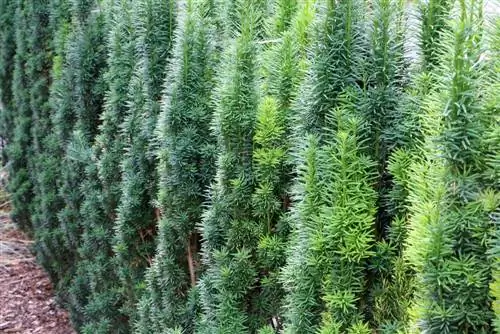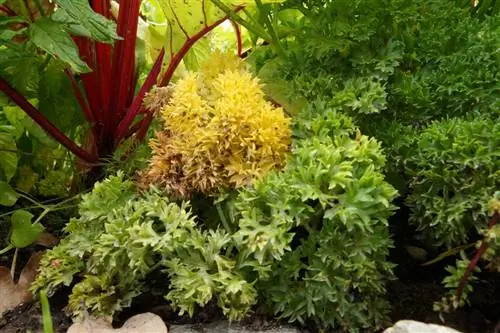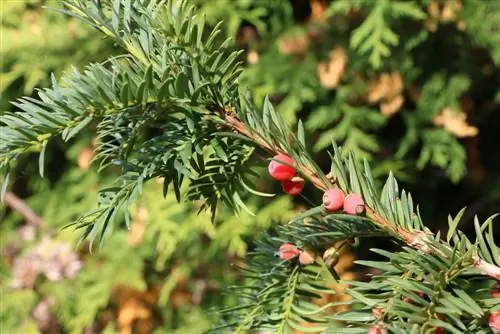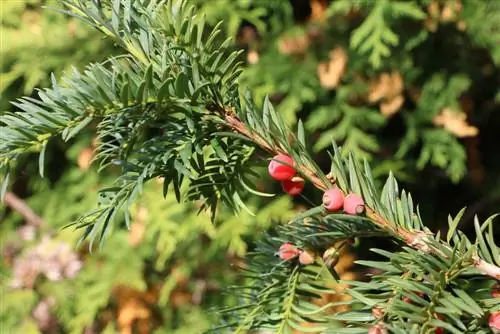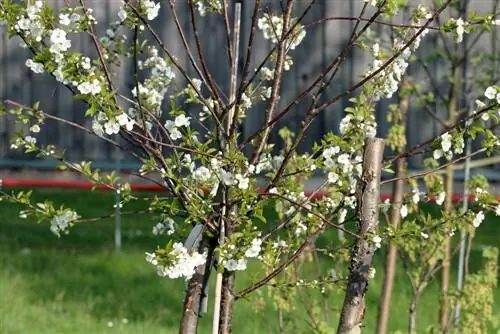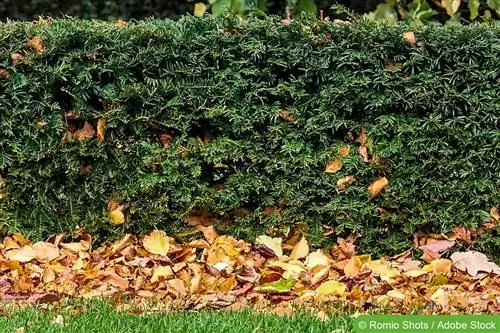- Author admin [email protected].
- Public 2023-12-17 03:39.
- Last modified 2025-06-01 06:48.
The columnar yew (Taxus baccata) stands out due to its very slender, upright growth habit. Thanks to this, the tree is ideal as a solitary plant in small gardens, but also for narrow hedges. In particular, the yellow and narrow columnar yew (botanically Taxus baccata 'Fastigiata Aureomarginata' and 'Fastigiata Robusta') are a pretty eye-catcher in the garden thanks to their characteristic growth and the striking, yellow-green color of the needles. The trees are considered extremely easy to care for.
The columned yew tree at a glance - a profile
There are around ten different species of yew, of which only the European or common yew is native to our latitudes. Botanically it is called Taxus baccata, which indicates that the columnar yews presented here are simply different varieties of the same species. For this reason, the trees should easily fit into your garden and feel comfortable there, after all, this is where they are at home. By the way, yews are closely related to the conifers, which are also very popular in many gardens.
- Botanical name: Taxus baccata
- Genus: Yew trees
- Family: Yew family (Taxaceae)
- Origin and distribution: exclusively in the northern hemisphere, in temperate latitudes
- Growth habit: slim, upright, very narrow, only getting a little wider with age
- Growth height: between four and six meters depending on the substrate and location
- Growth rate: slow, up to ten centimeters per year
- Characteristic features: evergreen
- Location: sunny to shady, but light partial shade is optimal
- Soil: moist, nutrient-rich, calcareous
- Leaves: needles up to four centimeters long, dark green or yellow-green with a golden border
- Flowering: March to April, inconspicuous
- Fruits: bright red berries
- Poisonousness: yes, all parts of the yew tree are highly poisonous (especially the fruits and the needles)
- Use: Ornamental plant, especially in the background of flowering herbaceous beds, as a solitary plant or hedge
- Winter hardiness: very hardy and frost-proof
Tip:
Yews grow very slowly, this also applies to the slightly faster columnar yews. It can take up to 20 years for such a solitary plant or hedge made of columnar yew trees to reach four meters high. So that you don't have to wait so long for your garden decorations, buy plants that are at least one meter high.
Differences between 'Fastigiata Aureomarginata' and 'Fastigiata Robusta'
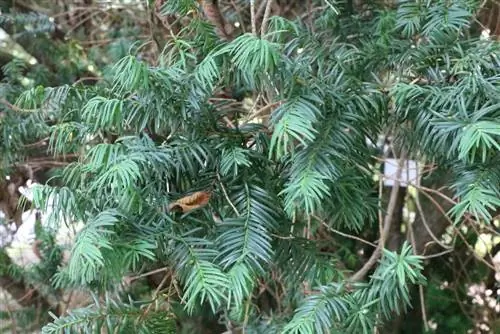
The two varieties of columnar yew presented here are very similar. 'Fastigiata Robusta' is, as its botanical name suggests, more robust and less sensitive to bad weather conditions than 'Fastigiata Aureomarginata'. It also grows slightly faster and has lighter needles.
But whichever variety of columnar yew you choose: They are all very easy to care for and are well suited for people with little time or without the famous “green thumb”. The trees native here can be planted in the garden or cultivated in pots. Keeping it in a pot is easy as long as the plant is watered and fertilized regularly. Furthermore, the columnar yew copes very well with both root competition and dripping rain or dew water from other trees. This is hardly surprising, since in nature yews are mainly found in the so-called shrub layer, i.e. H. they thrive below the canopy.
Caring for the columnar yew tree from A-Z
Even though the care of the columnar yew tree is basically very simple, there are still a few tips to keep in mind. This is how the yew tree grows and thrives wonderfully and gives its owner, his children and their children's children a lot of joy thanks to its extremely long lifespan - these conifers can live up to 1000 years in nature. The better the care, the more beautifully the tree will grow and form he althy, strong needles.
Location
Basically, columnar yews feel at home in any location: whether sunny or shady, the conifers can be found almost everywhere and are quite adaptable. However, the optimal place is in light partial shade, for example under a taller deciduous tree. Here the yew gets enough light, but is protected from the bright sunlight. Full sun can be problematic, especially in winter: in frosty but sunny weather, the plant evaporates a lot of water through its needles, but cannot absorb any through its roots. As a result, dry damage occurs, which appears on brown-colored needles. In a shady location, however, the already slow yew grows even more slowly.
The ideal location at a glance:
- sunny to shady
- light partial shade is ideal
- for example under a taller deciduous tree
- no full sun location for young trees
- high humidity is important
Soil / plant substrate
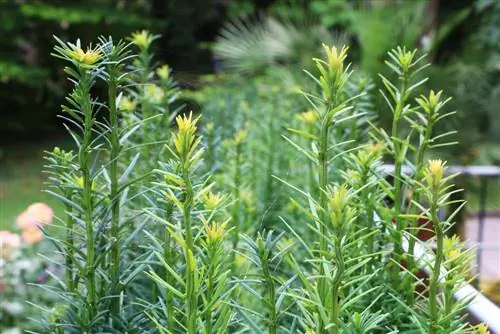
Basically, columnar yews do well in almost any garden soil, as long as it is not too acidic. Moor soils are therefore unsuitable, otherwise you can plant Taxus baccata almost anywhere. However, the plant feels most comfortable on nutrient-rich, humus-rich soil that, if possible, contains both clay and lime. Heavy soils should be improved with sand and compost, while sandy substrates can tolerate a generous addition of mature compost. If the columnar yew is cultivated in a pot, mix pot plant soil with mature compost and a few horn shavings. Be sure to ensure good drainage in the pot: although the yew needs a lot of water, it cannot tolerate drought or waterlogging.
Pouring
Columnar yews - like all yews - need a lot of water, especially immediately after planting and in the first two to three years.
The most important things about watering at a glance
- high water requirement, especially after planting and in the first few years
- good water supply helps to ensure good rooting
- good rooting allows drought times to be better survived
- Watere regularly, but avoid waterlogging
- good drainage therefore also useful for planted specimens
- Loose up the soil with sand and compost
- water even in winter, especially in sunny, dry weather
- Mulch the soil area to prevent drying out
Tip:
Coppery, shiny needles are a clear sign of a lack of water - the color is intended to prevent the columnar yew from losing more water than absolutely necessary through the leaves. Drying out and falling needles can be an indication of both waterlogging (i.e. too much moisture) and permanently too little water. In the event of waterlogging, you should stop the excess supply immediately and only care for the tree in question as usual again from next spring. The robust yew usually sprouts again quickly.
Fertilize
Optimally, you fertilize the columnar yew from the first shoots (usually mid-April) until mid / end of July at the latest. Later in the year, the plant should no longer be supplied with nutrients, otherwise the new shoots will not be able to mature in time for winter. As a result, they are highly susceptible to frost and other winter weather hazards. An exception is Patentkali, which is given between mid-August and mid-September and prepares the tree for winter. Fertilize two to three times a year with mature compost and horn shavings; if the soil is poor or cultivated in containers, use commercially available complete fertilizer. Special conifer or fir fertilizer is not absolutely necessary, but can also be used.
- from budding to mid / end of July
- for budding as well as compost and horn shavings in June
- for poor soils and container storage: liquid complete fertilizer
- Fir or conifer fertilizer can be given, but does not have to be given
- Patentpotash between mid-August and mid-September
Tip:
Fertilizing should always be done together with thorough watering so that the nutrients can be washed straight to the roots and absorbed as quickly as possible. Liquid fertilizer is added to the irrigation water.
Cutting
Pillar yews are very easy to cut and can even be placed on the cane without any problems - that is, cut radically to just above the ground. However, regular pruning is basically not necessary because the trees retain their upright, slender shape even without human intervention. Baldness is also rare, which is why a rejuvenation cut is not necessary. Nevertheless, pruning may become necessary, for example because the hedge needs to be trimmed or the solitaire has grown too large over the years. Dead wood must also be removed immediately.
- cutting is done either in early spring or autumn
- A cut around St. John's Day (June 24th) is often recommended
- if possible, do not prune in June: birds like to breed in yew trees and are then disturbed
- Topiary always before budding in spring
- use stencil for this
- Cut out dead wood and diseased shoots at any time
Tip:
When cutting the yew tree, be sure to wear sturdy gardening gloves to avoid direct contact with the poisonous parts of the plant and the no less poisonous plant sap. Before and after cutting, clean the garden tools used, firstly for hygienic reasons (to prevent infection with fungi or bacteria) and secondly to remove the poison.
Propagate
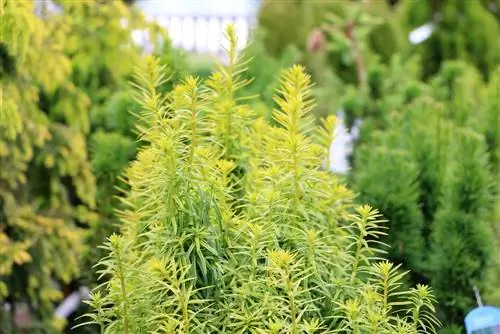
Although columnar yews produce pretty, bright red fruits in autumn, the seeds they contain cannot be used for varietal propagation. Instead, both 'Fastigiata Aureomarginata' and 'Fastigiata Robusta' are propagated via cuttings, which are traditionally cut on St. John's Day (June 24th). The reason for this lies in the fact that all specimens of the varieties mentioned worldwide are female and pollination can therefore only occur through other yew varieties.
How to root the cuttings:
- approx. Cut 30 centimeter long, two to three year old shoots
- Short the tips and side shoots by half
- Remove needles and side shoots in the lower area (which is inserted into the ground), about ten centimeters
- Plant cuttings in normal garden soil
- either in a pot or straight into the bed
- Location: shady and protected from the wind
- Keep soil evenly moist
- Be patient and wait
Because the columnar yews are so slow-growing, the cuttings take up to a year to develop new roots. As soon as new shoots form, root formation has been successful.
Wintering
Since it is a native yew species, columnar yews are very frost hardy. The only problem that can become problematic in winter is the combination of bright sunshine and bitter frost: then there is a risk of drought damage because the plant evaporates a lot of water but cannot absorb any. In this case, wrap the yew column in a fleece or wrap it with jute to keep out the sun.
Diseases and pests
Both diseases and pest infestations only occur very rarely in the columnar yew. On the other hand, discoloration of the leaves is more common, which indicates various problems: The brown discoloration usually occurs either due to a lack of water or due to too much moisture. Once the cause is identified and corrected, the robust Taxus baccata usually recovers quickly and resprouts.

